More Native Trees (from our archive)
November 2024: Sassafras, Sassafras albidum.
 Cape Cod’s sassafras trees are bare this month, but they were ablaze with color a few weeks ago.
Cape Cod’s sassafras trees are bare this month, but they were ablaze with color a few weeks ago.
Sassafras is notable not only for unusually shaped leaves and autumn hues, but also for the bark’s aroma of baking spices and vanilla. Female trees produce yellow flowers in spring that ripen into blue berries that birds and other wildlife enjoy. The leaves, host to the spicebush swallowtail butterfly, generally have three lobes, but can also be mitten-shaped or oval.
Safrole, the aromatic oil in the bark, was prized both by Native Americans and the English colonists. Indians used the root bark for restorative teas and treatments for colds and fevers. English explorer Martin Pring, commissioned In 1603 to assess the commercial potential of New England, noted the abundance of sassafras, then used to treat syphilis and ague, and loaded sassafras into his ship for the voyage home.
 The association of sassafras with healthfulness continued into the late 1800s when pharmacist Charles Hires formulated “root beer” from sassafras root bark and other ingredients as an alternative to alcoholic drinks. (Today, safrole is identified as a potential carcinogen, so root beer uses other flavoring agents.)
The association of sassafras with healthfulness continued into the late 1800s when pharmacist Charles Hires formulated “root beer” from sassafras root bark and other ingredients as an alternative to alcoholic drinks. (Today, safrole is identified as a potential carcinogen, so root beer uses other flavoring agents.)
Sassafras can grow into a single-trunked tree about 60 feet high or become a multi-stemmed thicket, especially in sandy, poorer soils, where it may be more likely to produce suckers. However, gardeners can remove the suckers and even prune the tree to the ground every few years to maintain it at shrub size.
Another way to enjoy the sassafras experience is simply to walk along the trails of the Baker’s Pond Conservation Area where sassafras grows among oaks and red maple. In summer or early fall these woods are a visual and olfactory delight.
April 2024: Black cherry, Prunus serotina.
 As Cape Cod’s April showers continue their rinse and repeat cycle, we impatiently scan our foggy landscapes for unfurling buds. However, in just one month, the bottlebrush white flowers and glossy green leaves of black cherry trees will be on full display.
As Cape Cod’s April showers continue their rinse and repeat cycle, we impatiently scan our foggy landscapes for unfurling buds. However, in just one month, the bottlebrush white flowers and glossy green leaves of black cherry trees will be on full display.
Once we see black cherry trees in bloom, we can appreciate how widespread they are in Cape Cod habitats, flourishing along the coastlines of saltwater estuaries and springing up further inland in sun-dappled woods. In sunny locations in moist loamy soil, black cherry trees will grow with a straight trunk as much as 60 feet tall.
However, because black cherry trees are prolific seed producers, saplings can also be found in much shadier, less appropriate spots, where their shape is curved and twisting as they seek the sunlight they crave.
For the gardener tempted to move a volunteer sapling to a sunnier location, it is best to attempt the operation when the sapling is less than a foot high because of the tree’s very long taproot.
Still, the seed production and dispersal makes sense in the species’ survival strategy. Because black cherry seeds "are often a major component of forest seedbanks in New England,” the Native Plant Trust notes, its seedlings are able “to establish rapidly after disturbances such as fires and logging.”
The tree’s ubiquity has benefited humans and (other) animals alike. Native Americans used the inner bark to create cough and cold remedies, and the edible but bitter cherries have been used in jellies and to flavor liqueurs. The wood is prized for furniture, veneers and musical instruments.
Numerous bird species feed on the cherries, and The Native Plant Trust considers the tree a pollinator powerhouse plant, as it hosts the caterpillars of more than 75 species of moths and butterflies.
February 2024: Pitch pine, Pinus rigida.
 Pitch pine is not a conventionally pretty tree. It looks craggy, even scruffy, at close range with Its scaly bark and stiff needles. But stand back to contemplate pitch pine’s gnarled branches against a blue sky, and it can have a fierce beauty. Its resin perfumes Mayflower Point woods on warm sunny days.
Pitch pine is not a conventionally pretty tree. It looks craggy, even scruffy, at close range with Its scaly bark and stiff needles. But stand back to contemplate pitch pine’s gnarled branches against a blue sky, and it can have a fierce beauty. Its resin perfumes Mayflower Point woods on warm sunny days.
The resin also makes the pitch pine highly flammable, and it has evolved to benefit from periodic wildfires. Pitch pines are often able to “green up” again at their crowns or to produce new shoots from their bases even after wildfires consume all their needles, according to a profile published by the USDA’s Forest Service.
 Barnstable County’s 2012 wildfire risk assessment acknowledges that the pitch pine barrens that dominate Cape Cod contain “highly flammable plant species that are adapted to survive or regenerate post fire.” It encourages residents to "limb up" all trees within a 30-foot radius of their homes by six to 10 feet above the ground, and to keep the crowns of pitch pines and other conifers within this radius 30 feet apart.
Barnstable County’s 2012 wildfire risk assessment acknowledges that the pitch pine barrens that dominate Cape Cod contain “highly flammable plant species that are adapted to survive or regenerate post fire.” It encourages residents to "limb up" all trees within a 30-foot radius of their homes by six to 10 feet above the ground, and to keep the crowns of pitch pines and other conifers within this radius 30 feet apart.
By taking such steps, we can continue to enjoy our proximity to pitch pines and the benefits they provide to a host of creatures. The US Fish and Wildlife Service classifies the tree as “high wildlife value” for the food it provides songbirds and small mammals, who appreciate the seeds its cones disperse beginning in late fall. The Native Plant Trust considers pitch pine a “pollinator powerhouse,” because 75 or more caterpillar species feed on its needles. Chickadees, blue jays and various warblers also rely on pitch pines for nesting and cover.
December 2023: American holly, Ilex opaca.
 You
don’t need to celebrate Christmas to venerate the American holly tree,
also known as Christmas holly. Its evergreen branches console our inner
pagan as the days grow short and dark.
The red berries that appear in autumn on female plants—if male plants
are nearby—pop against the dark green foliage and persist through the
winter if not devoured by birds.
You
don’t need to celebrate Christmas to venerate the American holly tree,
also known as Christmas holly. Its evergreen branches console our inner
pagan as the days grow short and dark.
The red berries that appear in autumn on female plants—if male plants
are nearby—pop against the dark green foliage and persist through the
winter if not devoured by birds.
While the berries are poisonous to humans, cats and dogs, they are a welcome sight to hungry robins, mockingbirds, catbirds, mourning doves and turkeys that overwinter or return in early spring.
Cape Cod and the Massachusetts shore represent the northernmost point of American holly’s range, which hugs the northeastern coast before broadening into a swath that extends west to Ohio and south to the Florida panhandle and eastern Texas.
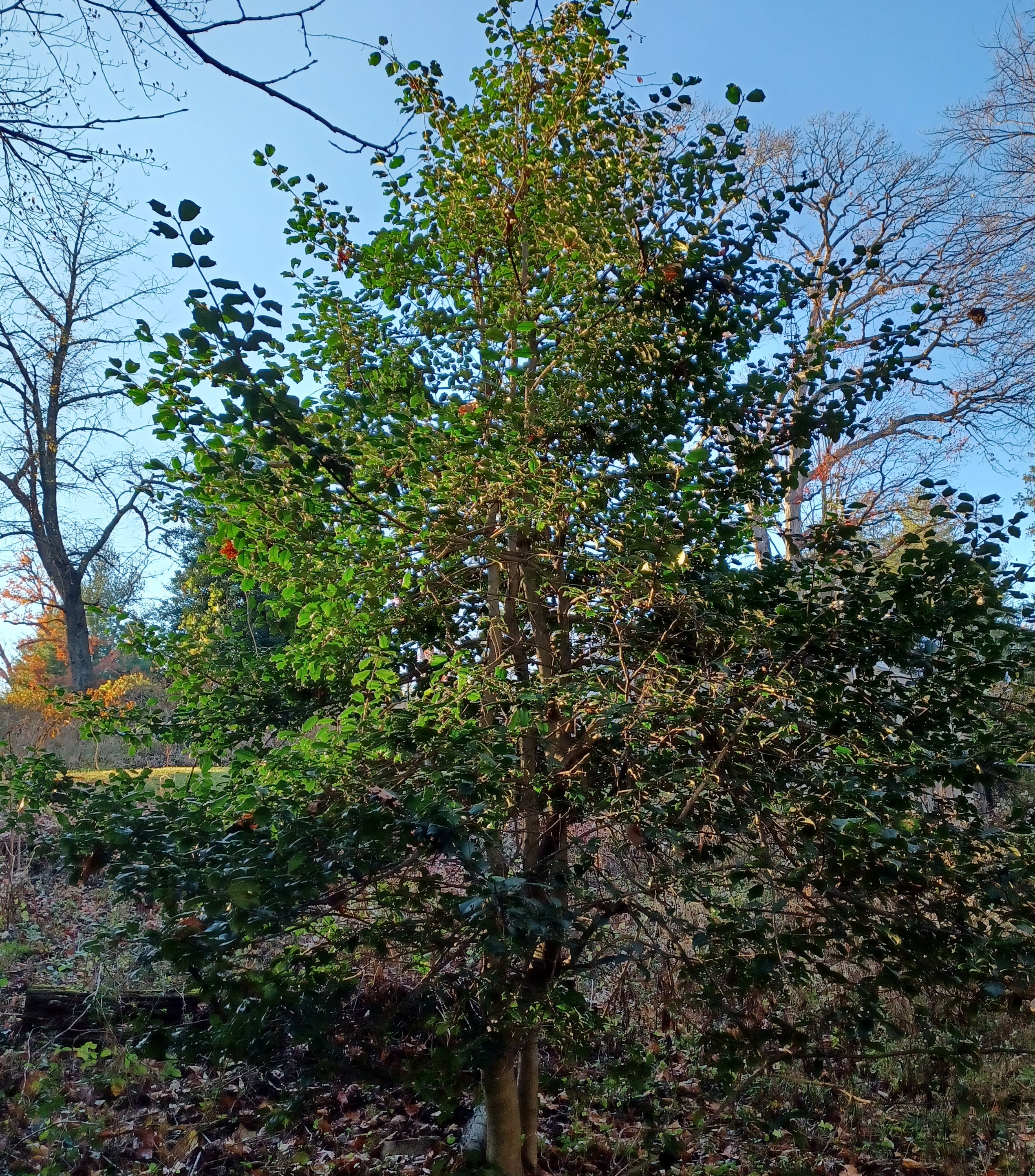 The
species name “opaca” refers to the opaque or dull sheen of its leaves,
which helps to distinguish it from English holly, a non-native sometimes
found in Mayflower Point woods. American holly leaves may be less lustrous than their English cousins’, but their spines are also less severe. You can brush against American holly without undue concern should you choose to deck your halls with its boughs.
The
species name “opaca” refers to the opaque or dull sheen of its leaves,
which helps to distinguish it from English holly, a non-native sometimes
found in Mayflower Point woods. American holly leaves may be less lustrous than their English cousins’, but their spines are also less severe. You can brush against American holly without undue concern should you choose to deck your halls with its boughs.
Ilex opaca is the only native holly that becomes a tree at maturity, rather than topping out as a shrub. The height of its shaggy, pyramidal form varies with location. In moist woods in the middle of its range, it can grow as tall as 50 feet, but on Cape Cod it is unlikely to surpass 30.
It prefers sandy or loamy soils, making it useful in stabilizing dunes,
and it can do well both in full sun and in the shade cast by taller
trees.
May 2023: Serviceberry, Amelanchier arborea.
|
This understory tree, typically no more than 30 feet tall, looks delicate but its range is vast: extending from New Brunswick to eastern Minnesota in the north to the Florida panhandle and northeastern Texas in the south.
The new leaves are covered in downy hairs, giving them a silvery cast. In the fall, the leaves turn an attractive purplish red. Downy serviceberry and the other serviceberries in the Amelanchier genus collectively host 124 caterpillar species, according to the tally provided by entomologist Doug Tallamy and ecological landscaper Rick Darke in their book, The Living Landscape. These caterpillars are a critical food source to birds migrating or breeding in the spring. Moreover, downy serviceberry’s blossoms ripen into red and purplish black berries in summer, further nourishing numerous bird species as well as other wildlife. |
February 2023: Eastern white pine, Pinus strobus.
If
we could travel back in time three centuries and walk about Mayflower
Point and much of New England, we might have to crane our necks to
see the tops of Eastern white pines growing as tall as 200 feet. Even
then, however, these magnificent trees were catching the attention of
the King of England, who declared that the tallest white pines in the
British colonies were reserved to be masts for the ships of the Royal
Navy. By the time of the American Revolution, according to the Maine
Historical Society, the tallest specimens had long disappeared. Logging
of Eastern white pines continued as our newly independent country
developed.
While old-growth pines can be found in a few pockets such as Mohawk State Park in northwestern Massachusetts, even the secondary and shorter versions we see in and near Mayflower Point are lovely with their soft, fine-textured needles.
Eastern white pines seem happiest in groves with each other and with other tree species; lone specimens are more vulnerable to pests. Squirrels and a wide range of birds—including cedar waxwings, chickadees, mourning doves, red-bellied woodpeckers and robins—find the trees appealing for their seeds or as sites for nests.
February activity: To see lush groves of Eastern white pines, visit the Peck Property just down Areys Lane from Mayflower Point or, slightly further south on Route 28, Kenrick Woods.
The trails in both conservation areas lead to Namequoit River just
below Arey’s Pond. Bring your binoculars, for there is a prominent dead
tree—a “snag”—on the Kenrick side, easily viewed from the Peck bank,
where one can sometimes find a bird of prey surveying the shallow waters
below.
January 2023: Eastern red cedar, Juniperus virginiana.
 Although
the Eastern red cedar is native to a broad swath of North America from
southeastern Canada to the Gulf of Mexico and from the Mississippi River
to the Atlantic Ocean, it seems iconic here on Cape Cod. We know it as
a “pioneer” species, the first tree to appear—like a sentinel--on the
bluff of a windswept coast or in the middle of a dry meadow.
Although
the Eastern red cedar is native to a broad swath of North America from
southeastern Canada to the Gulf of Mexico and from the Mississippi River
to the Atlantic Ocean, it seems iconic here on Cape Cod. We know it as
a “pioneer” species, the first tree to appear—like a sentinel--on the
bluff of a windswept coast or in the middle of a dry meadow.
Fifty years ago, a pair of red cedars at the rise of Higgins Landing overlooking Namequoit River were cut down in mysterious circumstances. Their loss is still lamented in some quarters, but another specimen has emerged a few feet further up the hill. We must be patient, because cedars grow very slowly, given their predilection for poor soil and harsh conditions. Nonetheless, they can eventually reach 30 feet or more in height.
The rewards are great. The silvery, aromatic berries of female cedars nourish over 50 species of birds in fall and winter. For humans, their evergreen beauty is solace in the short days of winter.
January activity: The coastal landscapes where we find eastern red cedars are also good places for winter bird-watching. Several species of birds that spend their summer months in Arctic regions find the Cape a balmy spot for the winter. Buffleheads (see image below), red-breasted mergansers, various scoters and other ducks can be spotted on the estuaries around Mayflower Point and on Nauset Marsh, seemingly untroubled by the blustery conditions.
November 2022: Oaks, Quercus.
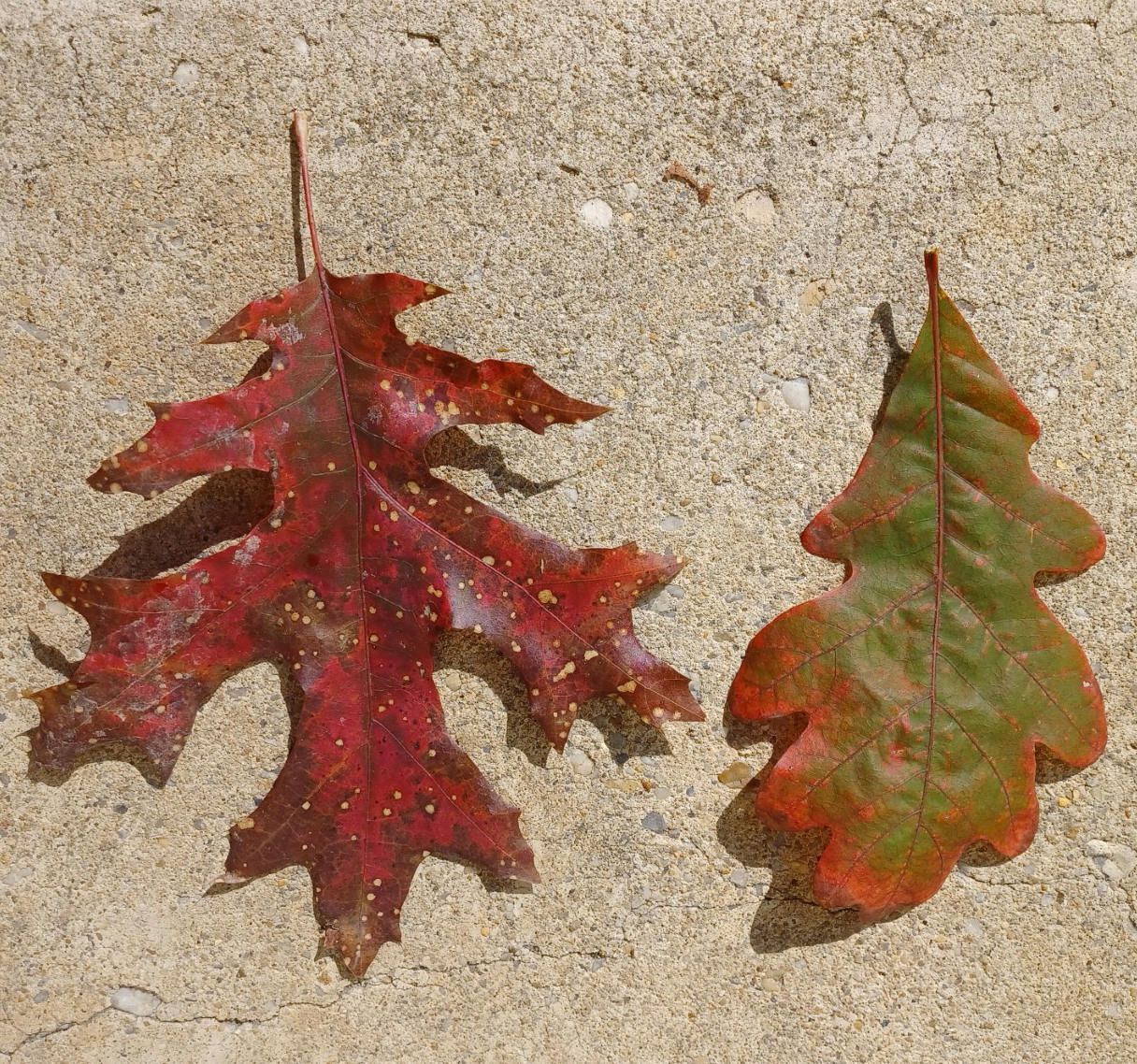 Oaks are found across the contiguous United States, and we are lucky to have many species native to Cape Cod, including the majestic white oak (Quercus alba). You can easily identify white oaks because their leaves are rounded, as shown at left in the picture below, while those of scarlet, red and black oaks are pointed.
Oaks are found across the contiguous United States, and we are lucky to have many species native to Cape Cod, including the majestic white oak (Quercus alba). You can easily identify white oaks because their leaves are rounded, as shown at left in the picture below, while those of scarlet, red and black oaks are pointed.
Oaks are rich in tannin, the compound that imparts its bitter flavor and preservative qualities to wine aged in oak barrels. Despite the tannin, a wide array of insects have co-evolved with oaks to be able to nibble and digest the leaves—and many of them are in the larval stage when our native birds are looking for caterpillars to feed their young. The leaves continue to shelter critical insects, amphibians and other woodland creatures after they have fallen and only slowly decay (thanks to the tannin). So oaks would be ecological superstars even if they didn’t produce acorns, but they do. Packed with fats and carbohydrates, acorns nourish more than 100 wildlife species.
November Activity: Nor’easter season is coming, and you can help your trees remain standing by making sure they are not blanketed in English ivy.
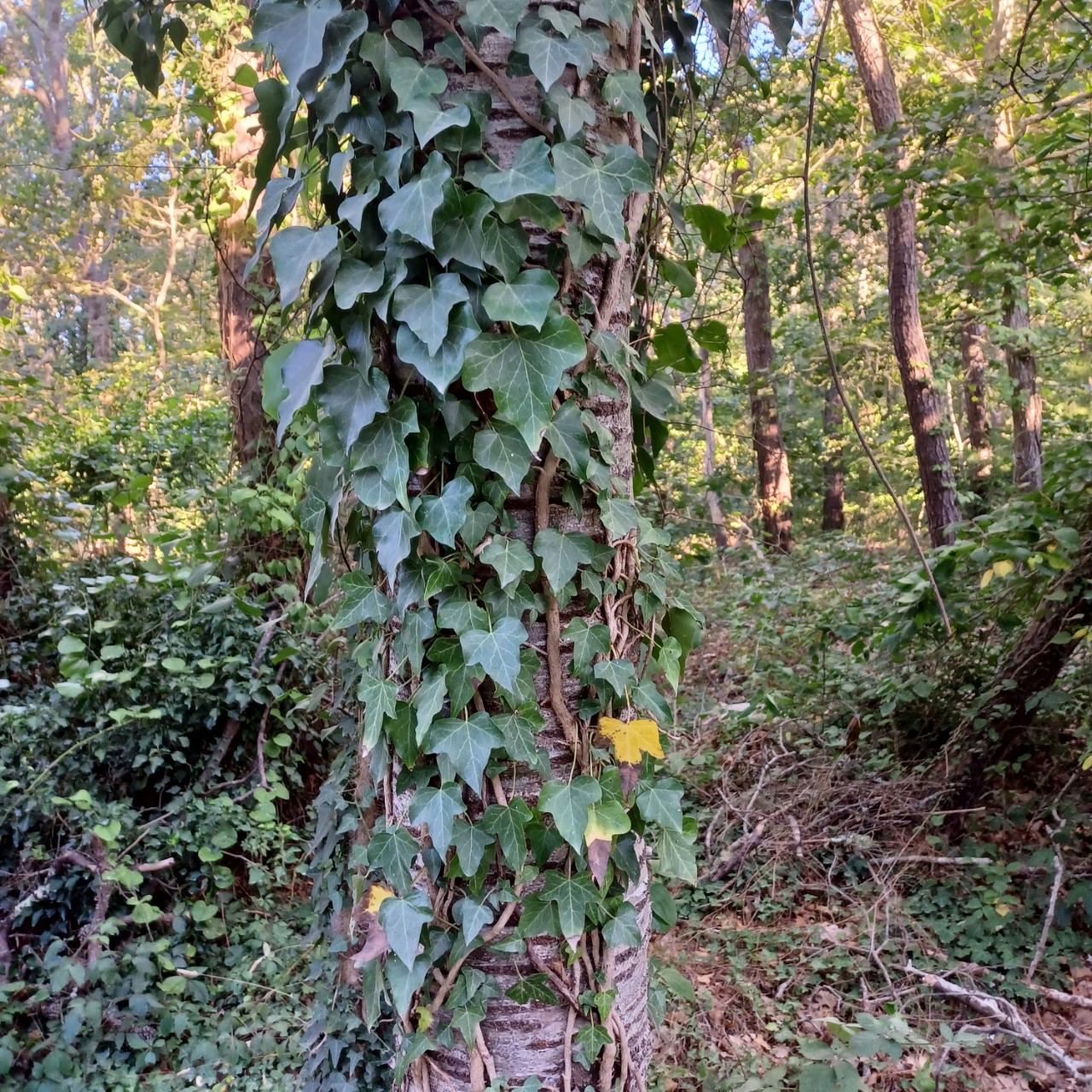
When English ivy climbs into trees, its evergreen leaves add to the weight and surface area of the trees, making them more vulnerable in heavy winds and storms. English ivy also carries Bacterial Leaf Scorch, a pathogen harmful to our native oaks and maples.
If it’s in your trees, cut each vine about 3 feet above the ground and pull away the vine below the cut. The vine above the cut will die. Do not pull away the ivy above the cut to avoid tearing away (more of) the tree’s bark.
October 2022: Red maple, Acer rubrum.
 Red
maple has a shy delicate quality on Cape Cod. It’s often hidden in the
shadows of the taller oaks and white pines that dominate our woods. It
prefers moist soils, so we are more likely to find it in low-lying
areas such as along the Red Maple Swamp Trail in the Fort Hill area in
Eastham.
Red
maple has a shy delicate quality on Cape Cod. It’s often hidden in the
shadows of the taller oaks and white pines that dominate our woods. It
prefers moist soils, so we are more likely to find it in low-lying
areas such as along the Red Maple Swamp Trail in the Fort Hill area in
Eastham.
But even on Mayflower Point, where the soil is drier, red maples dot our landscape. They seem to appreciate having their feet in the cool shade of taller trees.
And October is their month to shine, when their lovely 3- and 5-pointed leaves turn brilliant shades of red.
October Activity: In addition to taking walks in the woods to spot red maples, walk around your own property and keep an eye out for Oriental bittersweet.
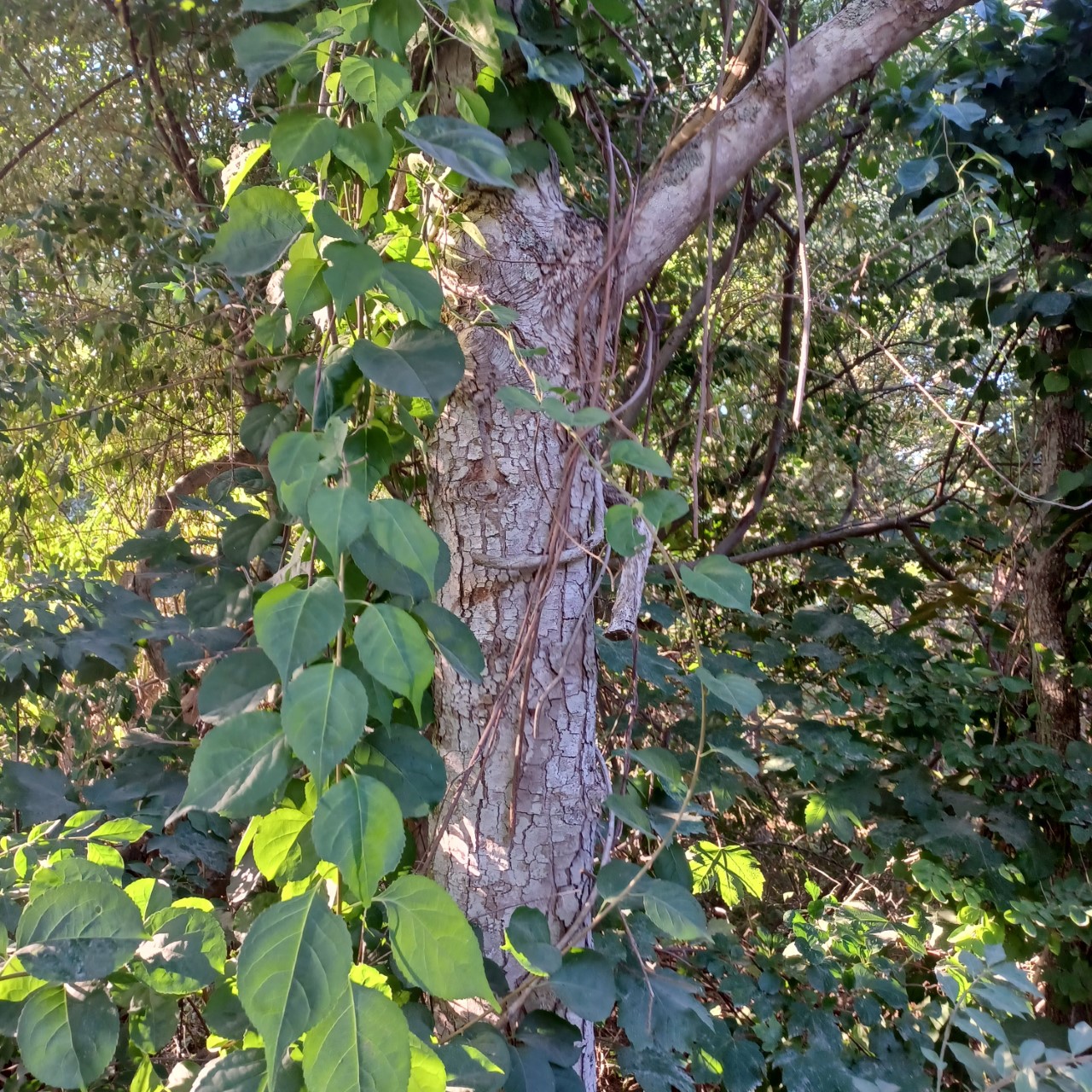 It
is an invasive non-native vine that chokes trees by twining around
them. It also grows profusely enough to blanket native shrubs and
deprive them of sunlight.
It
is an invasive non-native vine that chokes trees by twining around
them. It also grows profusely enough to blanket native shrubs and
deprive them of sunlight.
In the fall, it produces admittedly pretty orange and yellow berries, which birds eat, spreading the seeds. To stop the vicious cycle, you can pull young shoots by hand (especially from wet soil) or mow them. If a vine has engulfed a tree, cut a “window” in it, with a first cut a foot above the ground and the second several feet higher. The vine above the cuts will wither and free the tree.


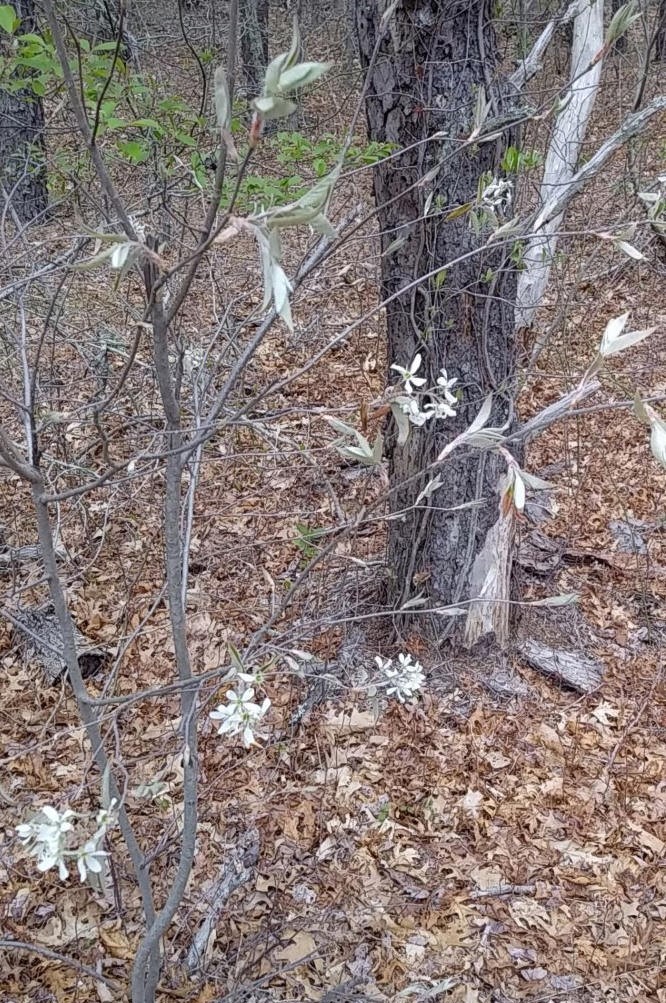 Its white blooms, which appear this month on Cape Cod before most of our local trees have leafed out, seem to float against the gray branches and trunks in the background. Because downy serviceberry is salt-tolerant, the blossoms are often visible in the woods close to the shorelines of our bays and estuaries.
Its white blooms, which appear this month on Cape Cod before most of our local trees have leafed out, seem to float against the gray branches and trunks in the background. Because downy serviceberry is salt-tolerant, the blossoms are often visible in the woods close to the shorelines of our bays and estuaries.